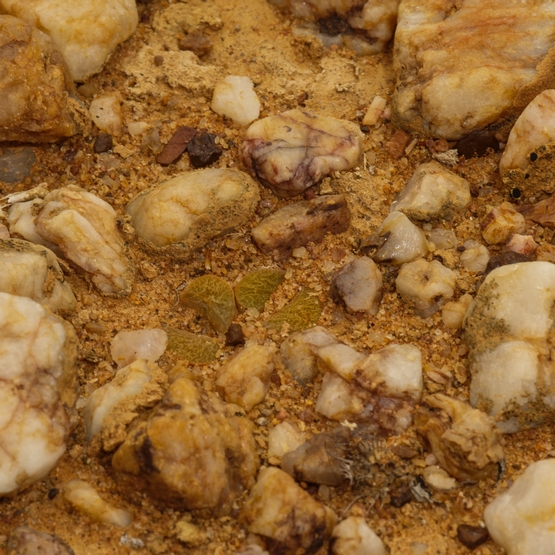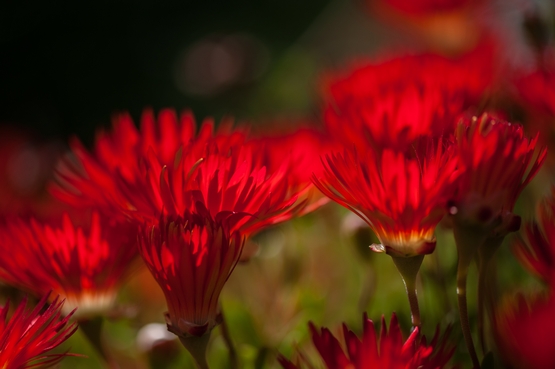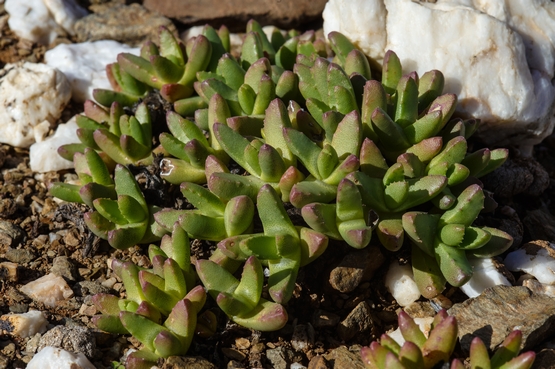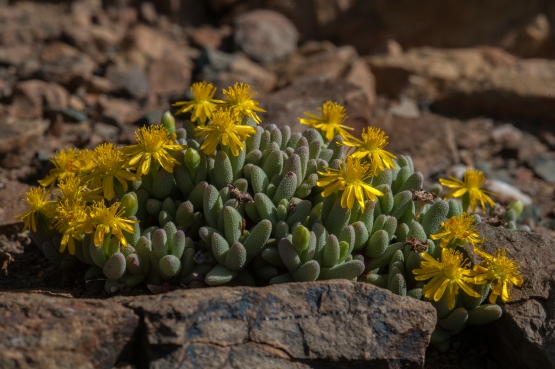Photographed 9 Sept. 2010 in the northern Knersvlakte.
Tag: vygies
Drosanthemum speciosum in a different guise
In my first post on this species, I referred to the fact that the flowers not only came in red, but also in orange. As I had never seen these in the wild, I could not show you a picture. In my former garden I even had a plant with yellow flowers, but as it originated from a nursery I could not be sure it was not a cultivar. So it would not be fair to show you a picture pretending it was of a wild plant.
I also mentioned that the plants are often seen along roads, but again I had no picture to substantiate this.
As it happens, I was on an outing yesterday that took me to the Ouberg pass, northeast of Montagu. Lots of flowering D. speciosum there, but non of them in red or scarlet as usual.

apart from a few almost pure yellow ones.

As a bonus, there was also a specimen growing almost in the road.
After three consecutive posts on one species, I will not mention it for a while now. Promise.
Drosanthemum speciosum, seen with different eyes
Yesterday I showed you some documentary type of pictures.
Confronted with all these beautiful flowers, it was clearly a waste of opportunities to not have another and different look at them. Although we talk about looking at things with different eyes, in reality we should call it looking with a different (part of the) brain.
In a case like this I usually have to take a deliberate decision to let the right hemisphere of my brain take over.
Once you are in that mode, it is sometimes difficult to stop; it is almost like being in a feeding frenzy. Anyway, I came home with a lot of pictures , many of which were very similar. This to me is one of the beauties of digital photography: the fact that there is no need to restrict yourself to taking a few pictures. Mind you, I’m not endorsing an attitude of just mindlessly taking lots of snapshots hoping that some of them will turn out right. (Recently I saw that nicely described as “point and pray”). But I do think that often it is good to “go with the flow”.
Below you will find a couple of pictures that for one reason or other seem worth showing to you.
The first three pictures give a general idea of the abundance of colour in these flowers.
The second pair shows a more deliberate approach. It’s a case of ” can you spot the difference(s)? “.
I found the old fruit in the first picture a bit disturbing, so I removed it before taking the second one. On reflection, I think that the fruit adds interest to an otherwise somewhat empty space in the picture. The fact that it also gives some extra information seems to me less important in this kind of picture.

The next photo was slightly cropped in post production, resulting in a very balanced image. For some of us probably even a bit too balanced and formal.

We end with a picture that I like because of the cheeky way a few of the petals refuse to follow the general pattern.

Drosanthemum speciosum
These plants, which may become up to 80 cm tall, are locally abundant from Worcester to Barrydale in the western Little Karoo and are often seen along roads.
The many flowers are about 5 cm across and usually flaming scarlet or red, although more subtle orangey colours also occur; they are present in late winter and spring (May-October).
In the next post I will show you some more flowers, photographed in a somewhat different way.
Peersia frithii
Peersia is a genus of only 3 species. They used to be included in Rhinephyllum, but the leaves miss the rough surface which is typical for the latter genus. They have a strangely S-shaped distribution area from the northern tip of the Western Cape, southwards to near Touwsrivier and from there eastward to the western part of the Eastern Cape.
The flowering plants were photographed 3 Nov. 2012, northeast of Prince Albert, the other two 9 Jan 2006, north of Laingsburg.
Stomatium suricatinum
Ruschia lineolata
Yesterday for the first time I took a serious walk in the Montagu Nature Garden. One of the interesting plants I came across is shown here. The first question when one comes across a plant looking like this is always: is it a Ruschia or is it an Antimima? Last years’ fruit pointed in the direction of Ruschia, so that is where I started. For me and -I suppose- most other people, reading dozens of plant descriptions is not a favourite pastime. After going through the specialized literature without any luck, I decided to turn to one of the most excellent fieldguides I know :”Plants of the Little Karoo” by Jan Vlok and his wife Anne Lise. As soon as I saw their picture of Ruschia lineolata I got the feeling that this was it. But of course one still has to check and double check and fortunately all the written information I found fitted in.
“Lineolata” means bearing fine lines, referring to the beautifully striped petals.
The plants form mats up to 1 m across and because of their abundant flowering this looks like a great garden subject in an appropriate climate.
Conophytum obscurum ssp. vitreopapillatum
Odontophorus marlothii
Rhinephyllum graniforme
Here is an example of how knowing the meaning of the name actually may help to recognise the species. (Rhinephyllum = leaf like a file, referring to the rough surface of the leaves; graniforme = shaped like a grain). The genus occurs from Laingsburg in the Western Cape northeastwards to the southern tip of the Free State.
The flowers are rather special in the sense that they open only late in the afternoon or in the evening.
Photographed east of Prince Albert 3 Nov. 2012.






























